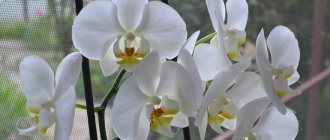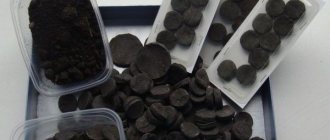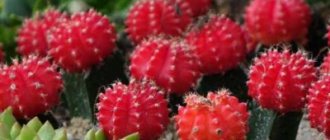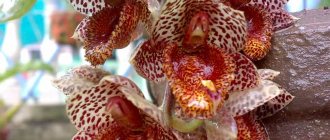It happens that or young sprout begins to rot Without paying attention to this, you can quickly lose the plant.
There is also no need to rush to throw away a flower; you can still cure it and subsequently admire the flowering.
Where is the growing point of various orchids? In monopodial orchids, the growth point is the top of the trunk , from which the leaves grow. These orchid species have only one growth point, and when it dies, the plant stops growing.
Growth point of a monopodial orchid.
The sympodial group is distinguished by the fact that it has several growth points , giving the orchid the opportunity to develop further if one of them dies.
Growth point of sympodial orchids.
Below we will tell you about various problems with the orchid’s growing point (no, it’s rotten).
Orchid without growing point
Reasons for her death
There are several reasons why a growth point dies:
- Water entering the growing point and staying there for a long time;
- Keeping the flower in a room with high humidity and low temperature;
- Sunburn;
- Mechanical damage;
- Fusarium wilt;
- Pest infestation.
The Internet often advises watering orchids with a shower. Yes, it is convenient, fast and, of course, useful.
Only few places mention that with such watering it is necessary to very quickly remove water from the growing point of Phalaenopsis or Vanda.
Simply getting moisture on a Cattleya bud that has just begun to wake up leads to its rotting . Therefore, many experienced orchidists advise not to water Cattleyas at all until the bud turns into a shoot 1-2 cm in height.
In Cambria, a new sprout develops under the covering leaves ; water that gets there is quite difficult to remove without damaging it. This is all the more unpleasant since Cambria has only three growing points: two on the sides and one at the top of the pseudobulb. It has no other meristem buds.
The mere presence of an orchid in a room with high humidity and low temperature can not only deprive the flower of its growth point, but also cause disease of the entire plant .
Attention! High humidity is permissible only at high air temperatures and regular ventilation of the room.
In the spring, when intensive development of orchids begins, sunburn of plants that have grown weaned from the bright sun over the winter is not uncommon. Tender young leaves and buds are most quickly affected. In this case :
- In sympodial orchids, another dormant bud will wake up after some time, if the burn is not critical;
- In monopodial orchids, a new leaf will begin to grow if only it was affected.
There are several reasons for rotting of the growing point.
It is much more unpleasant if the orchid is affected by a fungal infection such as Fusarium wilt, since this disease involves amputation of the affected area. In this case, the orchid will not only have to fight the disease, but also try to continue its growth by growing:
- Kids;
- Or a new sprout.
There is also nothing good about being attacked by pests. Insects, first of all, prefer soft young shoots , in which the bulk of nutrients are concentrated. Through them they suck out orchid juices and allow viruses and fungi to penetrate inside.
But what if the orchid does not have a growing point? We will tell you what to do and what to do below.
What is her role?
In the absence of a growth point, the plant cannot fully develop in the future.
That is, leaves do not grow, new shoots and flower stalks do not appear. No growth. This means that the function of the growing point is to initiate new shoots and lengthen the stem . Without this part, the plant gradually begins to die, leaving only one rosette, lower leaves and root system (you can find out what kind of roots a healthy orchid should have and what problems arise with this particular part of the flower here). Of course, it cannot be said with 100% certainty that the orchid will die. There are ways to help a flower without leaves, to provoke the growth of side children.
What to do if the growth point:
Rotten
First of all, don't give up . The life and growth of this tropical beauty is worth fighting for.
Why the growth point rotted: what to do in such a situation? The main reason for rotting of the growing point is :
- Water entering the growing point and staying there for a long time;
- Keeping the flower in a room with high humidity and low temperature.
If rotting of the growing point is detected at an early stage, then carefully remove the affected bud or leaf , sprinkling the removal site with cinnamon or activated carbon. It is quite possible that the point itself is not affected. In this case:
- A new leaf will begin to grow from the crown of monopodial orchids;
- Another meristem bud will quickly wake up, and a new sprout will develop in the sympodial ones.
When the discovery of rot occurred later, it is no longer possible to get by with “little blood” - you will have to cut out all the rotting tissue until it is alive . It is best to fill the surgical site with undiluted Maxim. You can do this with brilliant green, iodine or fucorcin, but you must remember that these are alcohol-containing preparations, they affect plant tissue several millimeters deep.
Subjected to mechanical damage
Mechanical damage may include :
- The fall of the orchid if the growing point is broken;
- Burn of a young leaf/growth that has just begun to grow.
The orchid can damage the growing pains when it falls.
The cases are unpleasant, but not fatal. In monopodial orchids, the death of the growth point is often mistaken for the death of the last regrown leaf - this is completely wrong. The growth point is the place located at the top of the stem . If the tip of the stem is not damaged, then everything is fine with the growing point.
Broken off or burnt growth of sympodial orchids is another matter. will no longer grow from this point , but a little later another bud will begin to develop. Is your orchid without a growing point? What to do in case of fusarium and pests - we will consider further.
Damaged due to fusarium wilt and pests
Often Fusarium wilt is a consequence of orchid damage by pests :
- Various types of ticks;
- Mealybug;
- Thrips;
- Scale insect and false scale insect;
- Aphid.
If the last four representatives of insects can be seen with the naked eye and have time to take appropriate measures, then ticks can only be detected with a magnifying glass .
As a rule, it is possible to find out that mites have settled on an orchid only after the plant is already infected with Fusarium.
Fusarium wilt begins in the pest affected area . First of all, these are young shoots and leaves. It spreads quite quickly. The lack of surgical intervention can destroy not only the growing point, but the entire plant as a whole.
Treatment must begin with the cause, that is, first of all destroy the pests so that they do not open new “doors” for the entry of infections.
Treatment for Fusarium wilt includes :
- Removal of disease-affected areas , at least 1 cm in both directions from the affected area;
- This must be done sharp disinfected instrument;
When the growing points wilt, remove all damaged areas. - You should not rush to cover the cut area with disinfectant. You need to wait 10-15 minutes;
- If a darkening of the cut or a purple ring on the trunk/rhizome is detected, the operation must be continued;
- It is best to treat the cut
- Water the orchid with fungicide after the cut dries.
It will take a long time to treat an orchid with chemicals against Fusarium wilt :
- Spraying leaves if any remain;
- Water anyway.
Attention! On the trunk of the orchid there are meristem buds from which a baby can develop.
Functions
Most often, orchids of the monopodial type (phalaenopsis or Vanda), distinguished by the presence of one growing point, are kept in a home greenhouse . The leaves of such orchids are formed alternately, occupying an opposing position and forming a rosette.
During the period of vegetative activity of the plant, the growth point continuously produces new leaves, as well as the axillary roots necessary for adequate nutrition of orchids.
Peduncles also appear from the interleaf space of fresh leaves . If the apical point of a plant is lost or damaged, the orchid stops growing, and in some cases dies completely without this part.
Features of care and maintenance
The orchid's maintenance regime will have to be adjusted . The plant must be moved to a bright place, but avoid direct sunlight.
For the first couple of weeks, the orchid does not need to be watered with fertilizers and stimulants, you just need to observe. Why? We must be completely sure that the defeat has not gone further and the process has stopped.
Moreover, feeding during illness will do more harm than good.
After the control time has passed, you can begin to treat the orchid with stress stimulants:
- Epin-Extra;
- Vitalizer HB-101;
- Zircon;
- Succinic acid.
many other stimulants on the market , but before using them, you need to familiarize yourself with what exactly they stimulate - a wounded plant does not need stimulation of flowering at all. Ointment is used as a growth stimulator.
Spraying the plant with biostimulants is excluded, due to the fact that moisture entering the growth point is fraught with relapse . You can water the flower or make lotions using cotton pads. The use of succinic acid is very effective: 1 tablet per 1 liter of water.
Succinic acid helps to restore the growth point well.
High humidity can also trigger re-rotting . The temperature should be relatively even: +20-24 degrees during the day with a slight drop at night.
The appearance of a baby or the activation of a dormant bud depends, first of all, on the general condition of the orchid. If the plant was healthy and strong before losing its growth point, then after 1-1.5 months the orchid will continue its development .
Otherwise, especially if the cause of the loss of growth point was Fusarium, further development will begin only after complete recovery . The probability of a positive outcome is 50/50.
Carefully! The use of Cytokinin paste in this situation to accelerate the birth of a baby is not recommended. Its contact with the leaves or roots of an orchid will lead to the death of the latter.
Why is there no growth point?
If the growth point is damaged or disappears, this is expressed in the following signs:
- At the initial stage, the leaves become yellow and fall off, but new ones do not grow.
- If it has been missing for a long time, the rosette consists of two or three lower leaves. The upper part is missing, and in its place a dried “stump” is visible.
- A fungus forms on the upper sinuses.
There are several factors influencing the abnormal development of the growth point. All of them are associated with errors in plant maintenance or illiterate care.
Rotting of the growing point
Orchids prefer high humidity and abundant watering to drought. Therefore, they are easy to “fill in”. The plant may rot if watering rules and humidity requirements are not followed. The basis for the shoots begins to rot if:
- The room has high humidity but low temperature. Moisture evaporates over a long period of time, which can cause the socket to rot.
- Lack of ventilation.
- When watering or spraying, water got into the rosette and leaf axils.
Rotting of the top of an orchid rosette manifests itself in the following:
- The structure and color of the leaves changes. They become soft, pliable, lose turgor, and acquire a brown tint at the base.
- Dark spots appear on the trunk.
- The above-ground part of the flower loses its stability.
- In advanced cases, the upper leaves fall off.
In addition to non-compliance with maintenance conditions, the core can rot due to mechanical damage. For example, if you leave them without antiseptic treatment.
Mechanical damage
The top of the socket can be damaged under various circumstances:
- Incorrect placement of the flower - if the orchid pot needs to be rearranged frequently, the risk of it falling is high. Therefore, you should choose the only place where the plant will be comfortable.
- Turning the pot over - plastic pots are often unable to hold a flower. Therefore, they are weighed down or placed in transparent, heavier pots.
- When replanting - when removing an orchid from a pot, you should not pull on the top of the plant. It is better to swing it from side to side at the base, slightly pulling it up.
It’s easy to avoid mechanical damage if you think about its location in advance, choose the right pot and prepare for replanting.
Sunburn
Exposure to sunlight can damage the top shoots of orchids. Most species are placed in well-lit places, but do not allow plants to be in bright sun.
On sunny days, spraying and watering using the “hot shower” method are also not carried out. Drops of water accumulating in the axils of the upper leaves and near the buds can cause burns. Therefore, watering and spraying is carried out either in the early morning or in the evening. The moisture on the plant must dry before the sun comes out.
Most often, the sun's rays affect the upper leaves, which do not affect the core. The danger arises during the active growing season, when tender leaves bloom at the growth site. They are susceptible to burns even from short exposure to the sun.
Damage by diseases and pests
The growing point may die if the orchid becomes infected with fungal or infectious diseases. The plant is susceptible to diseases if it is not cared for properly (overwatering, lack of light, grown in a draft) or if it is infected from other flowers.
Harmful insects worsen the condition of the plant, weaken it, and make it susceptible to infections. Orchids are attacked by aphids, mealybugs, scale insects, spider mites and thrips. Therefore, if there are diseases, you should inspect the flower for pests. Fungicides are used to get rid of insects.
Cylinder
Deformed development of an orchid, in which the peduncle grows from the place of the growth point. It will no longer be able to grow leaves or grow in height. But babies can form in place of the outlet.
The appearance of the "Snake Head"
Very rarely, in monopodial orchids, a snake head appears from the growing point - this is a peduncle . This happens because the life period for this plant is ending.
The appearance of a peduncle is an attempt by the flower to continue its existence in the offspring.
In this case, it is legal to use Cytokinin paste to get a baby. It should be borne in mind that its use does not guarantee the appearance of a baby , but it does give a chance. First of all, the orchid must be given the opportunity to bloom. Further:
- Trim the peduncle 1 cm above the first dormant bud;
- Carefully remove the covering scale;
- Using a disinfected needle, carefully apply 3-4 scratches to living tissue;
- Using the same needle, apply a little paste to the kidney, remove excess;
- After 7-10 days the kidney will wake up.
Important! Damage to a growing point does not mean the death of the entire plant.
Plant restoration
During the restoration of the orchid, the room temperature is set at 25-26 degrees. Watering is stopped. Resume 2-3 weeks after treatment. The application of fertilizers is excluded; they force excessive consumption of accumulated energy.
After a month has passed from the date of pruning the orchid, it can be treated with growth stimulants. The following products are suitable:
- Zircon - intended to relieve stress in plants, restore immunity after diseases, including fusarium. The drug stimulates root formation and helps protect against pests.
- Succinic acid is used as an anti-stress agent, thanks to which the orchid’s immunity is restored. It helps absorb nutrients from the soil and makes the root formation process faster.
- Epin-Extra – activates the protective functions of the flower, strengthening the immune system, stimulates the growth of the root system, “awakens” the plant. The effect of using the product is not immediately noticeable; first, nutrients accumulate for subsequent growth.
The drugs are applied at the root. Spraying can cause repeated rotting of the top. Some formulations (for example, Epin-Extra) are better absorbed by the leaves, which is why it will not be possible to avoid spraying. Therefore, when processing leaf by leaf, moisture should not be allowed to enter the rosette and leaf axils.
At this stage, you should provide sufficient lighting, but do not leave the orchid in the sun. If the procedure is carried out in winter, additional lighting must be turned on.
A cured orchid forms a new growth point, thanks to which it continues to develop and bloom.
Step-by-step instructions for rotting
Shakey
- The first step is to prepare the blade and disinfect it.
- Next, the entire damaged part of the neck is trimmed down to living tissue.
- The cuts are carefully cleaned with a blade.
- Then the soil and orchid are treated with a 0.2% solution of Fundazol. The product is poured directly onto the wound.
- This is done 3-4 times with an interval of 2 weeks.
- The pot is placed in the previous place, we wait for the side baby to appear.
To cope with a rotten neck of an orchid, watch the video:
At the growth point
- Remove all infected areas so that not a single dark spot remains.
- Disinfect the sections.
- If the disease is infectious or as a precaution, topical fungicides are used.
- The orchid will need constant inspection, because rotting may return.
If rot has affected the growing point, watch this video:
Cores
- Rotten places are removed.
- If necessary, the core is removed completely.
- After each cut, the tools are processed.
- Wounds are cauterized with cinnamon, iodine, and activated charcoal.
- Carefully monitor the condition of the plant.
External manifestations
Rot is a disease that is caused by phytopathogenic fungi and bacteria . In the process of development, decay leads to damage to leaf blades, stems, roots, and at a more advanced stage - to complete decay, drying out and rapid death of decorative flowers. Externally it appears as dark spots near the base of the exotic. Over time they tend to grow. This leads to yellowing and darkening of the leaves, and their further falling.
Condition of the orchid with this disease:
- Weakness.
- Poor decorative quality.
- The duration of flowering is reduced.
- Growth stops.
- Turgor is lost.
What is the best way to process it?
Chemicals
Fungicides are considered one of the most effective drugs. These products are intended to eliminate pathogens of fungal diseases in plants. Fungicides may contain the following components: mercury, manganese, organic substances, copper, aldehydes.
The most famous drugs:
- Fitosparin-M actively destroys fungus and bacteria.
- Quadrix - has a wide spectrum of action, based on azoxystrobin. It is used for preventive and therapeutic purposes.
- Copper sulfate - made on the basis of copper sulfate, the result is visible after just 3-4 hours.
- Bordeaux mixture is prepared on the basis of copper and also contains lime, which reduces the acidity of the soil.
- Mikosan - helps well in the initial stages of the disease, stimulates the immune system.
Traditional methods
For small affected areas at the initial stage of the disease, it is quite possible to use folk remedies:
- Iodine solution . Dilute 5-7 drops of the substance into 5 liters of water and spray the flower once a week.
- Mustard infusion . You will need 5 liters of hot liquid, in which you need to dilute 50 grams of mustard powder. Then the solution should sit for at least 2 days. Before use, dilute 1:1 with water.
- Garlic tincture . During the day, you need to infuse 100 grams of husk in 10 liters of water.
Although natural remedies are harmless and easy to prepare, they can still help only at the beginning of the disease.
Recovery period
After all the necessary treatments have been carried out, the weakened plant will need to create certain conditions. Experienced gardeners recommend transplanting the orchid onto a layer of dry bark without adding any components.
In this case, the orchid should be secured with a wooden stick. On top of it you need to create an impromptu greenhouse from half a cake box. Holes must be made in it for free access of air.
The optimal temperature during the recovery period should be +25–26 °C. Also, the orchid must receive enough light. If resuscitation is carried out in winter, then it is best to organize additional lighting.
A plant planted in this way cannot be watered for a week. Then they gradually begin to spray the edge of the substrate. Full watering should begin no earlier than after 2–3 weeks.
To quickly awaken dormant buds, you can additionally use the following growth stimulants:
- epin;
- zircon;
- heteroauxin;
- cytokinin paste.
When using them, you should strictly adhere to the dosages indicated in the annotation. When the recommended doses are exceeded, these drugs tend to inhibit growth processes.
Where to begin?
Before resuscitating an orchid with a missing growth point, you should first understand the causes of the damage. If the plant has suffered from mechanical stress, then there is no need to take any special measures. You can simply limit yourself to removing damaged tissue and treating the wound surface with cinnamon powder or charcoal.
In cases where the orchid has suffered from a putrefactive infection, you need to act more carefully. After removing all dead and damaged parts, the sections must be treated with fungicides. For example, foundationazole powder, well known to orchid growers, can be used for these purposes.
At the same time, you should know that resuscitation of an orchid without leaves and growth point is also possible. It will just take a lot of effort and time. And also if the plant begins to produce a peduncle during the recovery period, it must be removed. Otherwise, the last forces will be spent on the development of flowers and the orchid will die.
Causes of rotting
Diseases in orchids are divided into three groups:
- infectious;
- bacterial;
- viral.
The first two can be dealt with, but if the flower is infected by some kind of virus, the plant will have to be destroyed. Even the most experienced gardeners are sometimes unable to understand these diseases. The most common disease is rotting of the core and leaves. They start to deteriorate from the base. Such a place becomes damp or various spots begin to appear. In addition, note:
- weakness;
- appearance deteriorates;
- turgor is lost;
- growth stops;
- photosynthesis is inhibited.
The main thing is to detect a deviation in a timely manner and make a correct diagnosis in a timely manner.
It is important to understand why this happened. Here are the reasons why the orchid has rotted:
- errors in care;
- bacterial infection;
- very dense soil;
- unsuitable fertilizers.
The solution to the problem of improper care is:
- in revising the irrigation system;
- it is worth raising the temperature;
- insufficient humidity;
- transfer.
There are many types of rot; you need to carefully examine the plant and understand which one has affected the flower:
- fusarium - the leaves become soft, on which a characteristic pink coating appears, and after it marks with pink halos;
- pythium - leaves begin to rot in the middle, turn yellow and fall off;
- late blight - black or dark brown rot appears, then turning into watery areas;
- wet bacterial - the appearance of dark wet spots on the leaves;
- gray – a fungal disease, locally gray fluffy islands appear;
- black - if you keep the plant in a cold room, black spots appear at the base.
The reasons that the orchid has rotted may be mechanical damage or frostbite. The beauty is damaged by replanting, by the peduncle holder, or simply by dropping the flowerpot. In such cases, the wounds need to be treated with bactericidal substances:
- crushed activated carbon or charcoal;
- ground cinnamon;
- iodine;
- brilliant green.
The plant can become frostbitten if it is not watered correctly during the cold period. Beginning gardeners give their orchids steam baths in the shower and then place them on the windowsill. The remaining moisture and cold air currents create conditions for the core and leaves to begin to deteriorate. This is also helped by poor lighting with a lack of sunlight.
The source of trouble can also be a wet substrate or soil that does not have time to dry. Because it may be chosen incorrectly. Unsuitable bark is heavy and dense, there is poor air circulation in it, and the water here does not have time to dry out.
Harm can also be caused by excess fertilizers, which create a supersaturation of nitrogen, leading to the appearance of cracks. The flower gradually withers and rots in the presence of various parasites, as they skillfully hide. In this case, the hardest thing is to find out who exactly settled in the flowerpot. To find out the type of insect:
- leave a piece of apple or other fruit in a flowerpot overnight;
- The plant is immersed in a container of water.
The most common parasites include:
- ticks;
- click beetle;
- mealy worm.
The click beetle can come from the street and feeds on the root system. Therefore, when bringing a new plant into the house, keep it separately to check whether there are harmful insects or not. An incorrect diagnosis can lead to confusion between parasite infection and a fungal infection, anthracnose. With it, the plant dies very quickly if it has low immunity.
If such problems arise, the plant is isolated from others for quarantine and processed. The nearby plants are also examined.
What are the consequences?
Since the flower has one growing point, you need to make sure that it does not rot . After all, after its death, development will stop, and the plant will subsequently die. Also, if the core rots, the orchid loses its foliage. It becomes soft, loses its elasticity, and then falls off completely. Next comes damage to the roots (why did the orchid’s roots rot and how can the plant be revived?).
With high humidity in the room, the infected areas of the flower become overgrown with rot spores, and this can spread the disease to other pets. Therefore, it is very important to know what to do if the orchid rots and urgently take measures to eliminate the disease. Only timely help will give the orchid a second chance at life. In the later stages, nothing will save you.
Prevention
- Maintaining optimal temperature is an integral part of care. In summer it should be +23..+25 degrees, and in winter it should be within +15..+18. Differences no more than 5 degrees.
Air humidity 50-50%.- In the first week after the procedure, no watering is required. Then you need to let the soil dry out and not water more than once every 10 days.
- Stagnant water must be removed from the sinuses.
- The use of mineral preparations is excluded.
- The lighting is not bright and diffuse.
- Ventilate the room with the orchid periodically.
It is important for all orchid lovers to remember: only in weakened plants can the neck and other organs begin to rot . When an exotic flower has good immunity, it is not afraid of anything. Follow the basic care rules, then you won’t have to take emergency measures.











